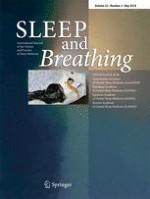Erschienen in:

28.10.2017 | Sleep Breathing Physiology and Disorders • Original Article
Effects of respiratory muscle training (RMT) in patients with mild to moderate obstructive sleep apnea (OSA)
verfasst von:
Simon Dominik Herkenrath, Marcel Treml, Christina Priegnitz, Wolfgang Galetke, Winfried J. Randerath
Erschienen in:
Sleep and Breathing
|
Ausgabe 2/2018
Einloggen, um Zugang zu erhalten
Abstract
Purpose
Different forms of training focusing on the muscles of the upper airways showed limited effects on obstructive sleep apnea (OSA) and/or snoring. We investigated the effect of generalized respiratory muscle training (RMT) in lean patients with mild to moderate OSA.
Methods
Nine male subjects (52.0 ± 10.8 years, BMI 29.1 ± 2.1 kg/m2) with obstructive sleep apnea (apnea-hypopnea index (AHI) 9–29) participated in an open, single-arm pilot study. After a 1-week build-up phase, patients underwent 4 weeks of normocapnic hyperpnea RMT five times a week for 30 min each. The initial and final measurements comprised polysomnography, pulmonary function tests, Epworth sleepiness scale (ESS), and SF-36 questionnaire (quality of life (QoL) self-assessment). The investigational site was a university-affiliated hospital for pulmonary diseases and sleep medicine, Solingen/Germany.
Results
Patients trained effectively, seen by a significant (p < 0.01) increase of breathing frequency (23.3 ± 1.5 /min vs. 30.6 ± 2.9 /min) and minute volume (81.2 ± 13.7 L vs. 109.1 ± 21.9 L). AHI, snoring and ESS remained unchanged after training. QoL as measured by SF-36 significantly (p < 0.05) improved after the training in the subscales “bodily pain” (79 ± 21 vs. 90 ± 12) and “change of health” (3.1 ± 0.3 vs. 2.4 ± 0.5).
Conclusions
There is no evidence that AHI, pulmonary function or daytime sleepiness are affected by 5 weeks of RMT. Nevertheless, there is an improvement of parameters of quality of life.











